-
Posts
5,391 -
Joined
-
Last visited
-
Days Won
3
Content Type
Profiles
Forums
Blogs
Gallery
Events
Store
Posts posted by Gordon Williamson
-
-
Couple of bits of info I just came across.
What was the first Luftwaffe aircraft type to see combat action in WW2 ?
What was the last Luftwaffe aircraft to be shot down in a dogfight in WW2 ?
0 -
[Well spotted John. Now the tricky part. Is there any way to tell from this angle whether its the common "C" model, or the "V-1" variant which was used as an air-ambulance ? I think, though I'm not sure, the only difference was in the cargo doors but they aren't visible on this shot.
0 -
Can anyone identify this plane ????
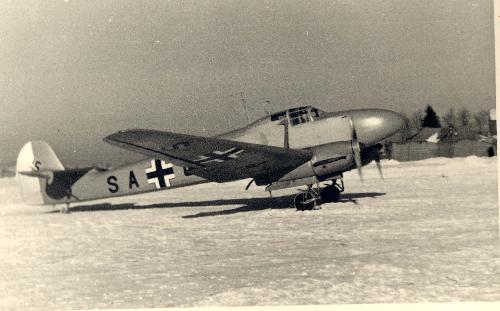
 0
0 -
Re von Thoma, all veterans stories have to be taken with a "pich of salt" of course but I remember back around the early 1970s a friend of mine had an antique shop. A vet came in and sold him some stuff which if I recall correctly was reputedly taken from von Thoma when he surrendered . Amongst the items ( again I am working from a 30+ year old memory,) were a Generals shoulder strap, collar patch and a beautiful CEJ Spanish Cross in Gold. All the items were 100% original, no doubt of that. Whether the story can be believed is another matter, but the old guy would have no reason to make the story up especially as the price he asked for them was, I recall, very cheap.
0 -
Firing the enamel
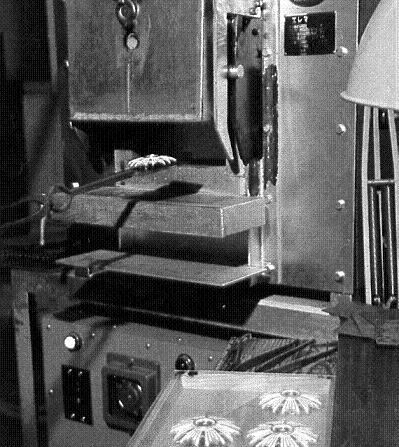
 0
0 -
-
-
Here the stamped out components are being hand finished. Note the initial finishing process is done using a fairly large, coarse file to remove any flashing, then a fine cut jewellers needle fine is used to finish the job
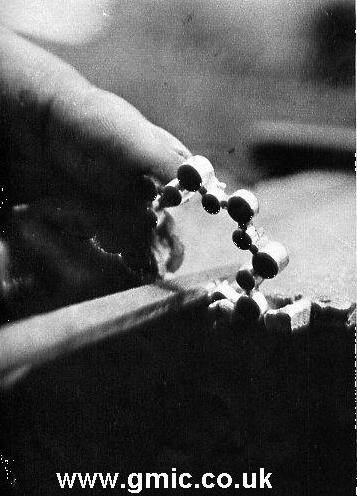
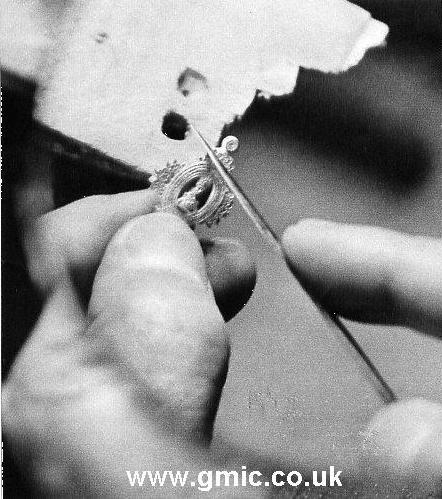

 0
0 -
Here, the award components are being stamped out. Modern presses are often hydraulic as the one shown here. The pressure required of course will vary dependant on the metal. Going by its size this one looks like a 20 / 25 ton press.
Note the die inserts with the shape of the award are cut into circular steel steel. This is then hardened and when in use fits into a recess in a normal mild steel die block.
The second example shown is a 25 ton press but with the pressure produced by a large flywheel on the side of the machine rather than by hydraulics, in the 30s/40s, most presses were flywheel types.
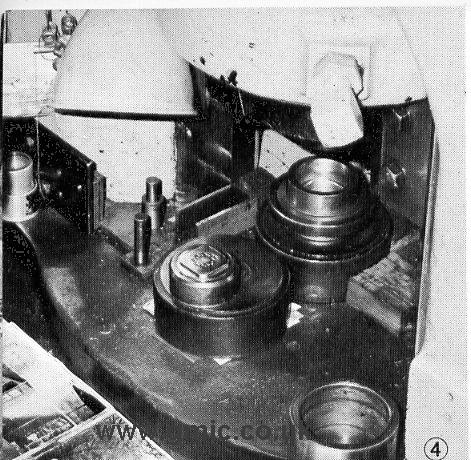
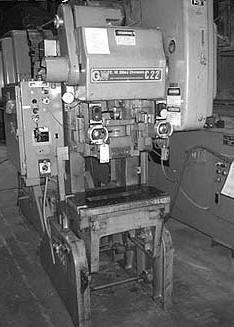

 0
0 -
A pantograph milling machine cuts the x10 or whatever pattern, scaled down to 1:1 into a steel block.
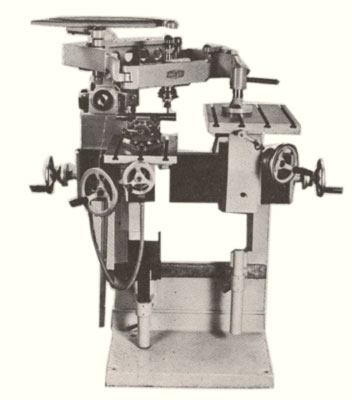
 0
0 -
This series of photos showing the manufacture of an award isn't actually 3rd Reich, but Japanese. The procedure is pretty universal however and gives an good basic overview of how the awards were produced. The first shows the pattern maker hand cutting the large (usually at least x4, often x10 ) master of the award which will by scaled down on a pantograph milling machine to actual size in the die insert. Traditional methods here, none of your laser cut dies used today.
The second photo shows the store rooom for these hand cut master patterns ( I suspect at the Osaka Mint)
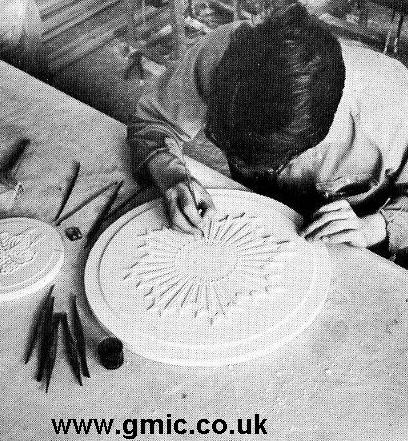


 0
0 -
These heavy cellulose thread hand embroidered pieces were worn by both officers and NCOs. It is generally considered that those like the ones on this page, with black highlight threads, are NCO and those in all golden yellow thread with no black highlight threads are officer.
Of course the hand embroidered gold wire versions like this were also worn by officers - and NCOs.
Very nice Gordon. Yes they are close to the same. Do you have an example that would be worn on a Commanding Officers tunic?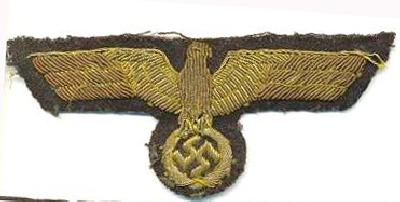
 0
0 -
Close up of makers label.

 0
0 -
Not quite identical to yours Darrell but very nearly
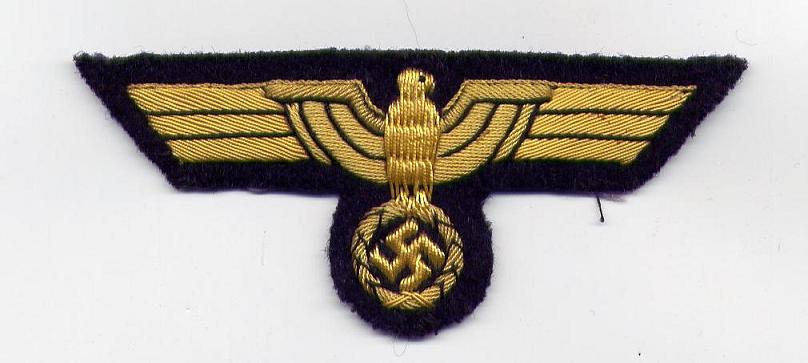


 0
0 -
Rick is correct. The DD hat eagles come in two styles, one has the cockade physically attached to the eagle, and the other , earlier type like this is worn with a separate cockade.
0 -
The hand embroidered one is the type typically worn by NCOs on the reefer jacket, the other is the standard BeVo weave enlisted mans eagle used mostly on the blue pullover shirt.
I have the identical hand embroidered piece with the original makers label still attached to the reverse, I'll post it later for comparison.
0 -
Gordon? how do I get more than one pick up on the sale forum?
You should be able to get multiple images in a single post so long as the total of them all doesn't exceed the overall limit per post.
If you are having problems getting more than one image , you can use the reply function and add new posts to the thread each with another view of the cap.
0 -
The "26" EK1s from the Russian hoarde are burnished.
Thre Gablonzer method was available to all makers in the sense that the firm never patented the system and offered other makers the facility to use the process. However, that would still have entailed any maker wishing to change systems having to purchase new machinery. I suppose it would have depended on the numbers being manufactured. For one of the smaller firms only manufacturing them in small numbers it probably wouldn't have been cost effective to change processes. On the other hand major manufacturers like Steinhauer for whom it might have made sense, don't seem to have bothered.
0 -
I agree that the EK2s made by the Gablonzer method do not tend to show evidence of burnishing. They also tend to lack the "white" frosting to the inner part of the frame. I've had mint unissued Gablonzer type specimens without frosting. The pressing process leaves the ribbed inner frame slightly coarser in finish to the outer flange in any case, giving a contrasting appearance.
Bear in mind that some firms may have used traditional methods before the introduction of the Gablonzer process so you may find both traditional and Gablonzer styles crosses with the same maker mark.
Presently is there any way to identify an 1939 Iron Cross made by the Gablonze method?If there isn't I propose that an Iron Cross that is in it's original state of issue that has evidence of burnishing was made by the standard method of stamping out the frame using sheet metal. The absense of burnishing is from using the Gablonze method which at least in Bowen's book "The Prussian and German Iron Cross" suggest the the high sheen that resulted made it un-necessary to burnish.
I have two EK2's and 2 Ek1, both appear to have not been burnish, but may have been polished afterwards by somebody after issue.
The Ek1's one "26" B.H. Mayer, and a "L/56" Funcke and Bruninghaus The later has burnishing marks but the former does not suggesting perhaps that Meyer who did produce many EK's may have used the Gablonzes method whereas the Funcke and Brunninghaus was a small contractor and did not have access to the technology.
I know looking a 4 EK's does not confirm the theory, it would take looking at many different makers and many samples of those makers to make a determination, but it could be a interesting project.
For those who are not familiar as to what to look for, look at the picture below.
0 -
Sounds like you've got the main ones. There are some posthumous types which used the standard document and had the additional text typewritten in rather than printed. I haven't come across an A5 posthumous type. There is also a posthumous type with mixed font types, looks like the printers used a template for the standard doc then added additional text, but in a different font.
0 -
The numeral 6. with the dot is for Fritz Zimmermann of Stuttgart. The makers mark sounds just right (presumably in incuse relief ?) Could well be a good one.
0 -
There are actually two versions of the case. The other is longer, the additional section containing two stickpin miniatures. The case lining and exterior covering is identical for both types.
The detail is indeed stunning. Most miniatures look quite good until you look at them in extreme close up, but this little beaut is perfect. The stippling to the arms of the cross is astonishing, likewise the detail to the sword hilts etc.
Reinforces my own personal feeling that very few other manufacturers approach Steinhauer for quality.
0 -
I have in fact seen a couple of caps with removeable tops where the top was definitely one from a sailors cap. While it might matter to the purist collector, I'm sure it didn't matter much to the sailor at the time. Externally there is very little difference, its all to do with the interior lining.
These tops do appear from time to time though. I've seen several for sale over the years so don't give up on getting the correct top. Of course the difficulty would be getting a size match, but its not impossible.
0 -
Very interesting piece. Never seen this type of fitting before. As Darrell says, you'd need views of it taken apart to be sure. One thing about fakes, - they rarely turn up in "ones". If a load of this style start turning up it would be a worry, but based on just this one, I wouldn't be too quick to write it off.
0





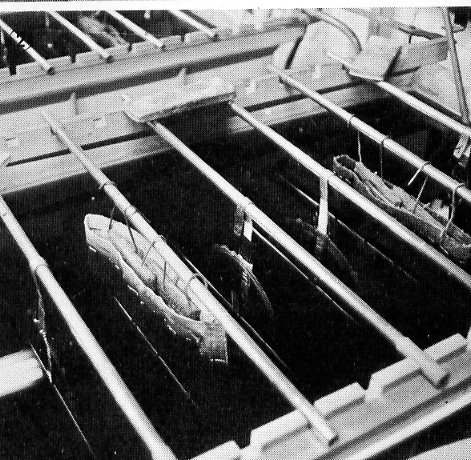
Trivia Question
in Germany: Third Reich: Wehrmacht Medals, Decorations & Awards
Posted
First Luftwaffe aircraft to see combat in WW2 was a Ju87 "Stuka" from St.G. 1 which led the assault on Poland by attacking a blockhouse containing the detonators for explosives the Polish troops had attached to a strategically important bridge.
The last dogfight is more interesting as it involved totally different aircraft than you'd expect. It was actually between a Fieseler Fi156 "Storch" and a US Piper "Cub" spotter plane. The American plane spotted the Storch and attacked. Of course the Cub is unarmed, so how did it attack and shot down the Storch ---------
The answer is the crew took pot shots at the Storch with their Colt .45 automatic pistols and managed to damage it enough to bring it down.